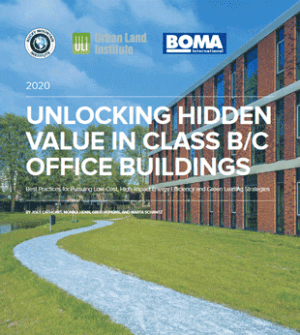Improved energy efficiency of class B and C office buildings can be achieved with relatively simple, lower-cost measures that not only enhance building performance, but also boost property values to make the buildings more competitive with class A space, new ULI research shows.
Unlocking Hidden Value in Class B/C Commercial Buildings explores the opportunities and challenges associated with incorporating energy-efficient retrofits and upgrades in buildings that tend to be bypassed for such improvements because of skepticism regarding the payback for the effort. The report, supported with funding from the Building Owners and Managers Association and Yardi Systems Inc., was prepared by the ULl Greenprint Center for Building Performance and the Rocky Mountain Institute.
“In a changing market with evolving tenant preferences, new energy efficiency technologies, and continued policy action to reduce building emissions, buildings implementing energy efficiency can stay ahead of the market,” says Billy Grayson, executive director of the ULI Center for Sustainability and Economic Performance, which includes the Greenprint Center.
Unlocking Hidden Value points to the disadvantages keeping class B and C property owners and managers from fully embracing green building practices:
- Information constraints. Stakeholders are often so consumed with daily operations that they do not focus on staying abreast of best practices in energy efficiency.
- Resource constraints. Class B and C buildings rarely have staff dedicated to energy efficiency efforts.
- Funding constraints. Budgets and capital planning for these buildings tend not to be large enough to support significant energy retrofits with large upfront costs.
Despite these obstacles, a strong business case exists for making the investments: the report notes that class B and C properties could save about 15 percent on energy costs by employing low-cost to no-cost measures, and 35 percent or more through larger expenditures that are paid back within just three years.
One example of the potential value of energy-efficient investments in class B office buildings is 1100 17th Street in Washington, D.C. When Akridge acquired the building, built in 1963, the top complaint from tenants regarded the induction units that provided heating. Instead of replacing the systems, building engineers cleaned and “retro-commissioned” each unit. Building system tune-ups were a lower-cost option than replacing the heating units, which shows the importance of routine maintenance: improvements to the system reduced tenant complaints by 90 percent.
“Although class B/C office tenants may not pay higher rental rates, owners are more likely to lease more quickly than competitors and retain those tenants during lease renewals when a space is more sustainable and energy efficient,” Unlocking Hidden Value states. “For the ambitious owner looking to reposition a class B or C office asset into an A property, incorporating energy efficiency measures into renovations provides an opportunity to add long-term value via new building systems and improved operational efficiency.”
The report also notes that local building performance ordinances are expanding beyond the largest commercial properties to include smaller buildings that often fall into class B and C categories, making green investments necessary for regulatory reasons as well as lucrative for economic reasons.
To overcome limitations related to information, capacity, and funding, Unlocking Hidden Value offers the following recommendations:
- Lay the foundation. To better understand the energy efficiency opportunities available, tap into local education and professional networks, garner buy-in from experienced property managers, and start benchmarking building energy data.
- Optimize resources. Prioritize actions that do not require much staff effort or investment. Optimizing building operations ensures that equipment operates effectively, lengthening its life span and improving efficiency.
- Reduce the cost burden. For capital-intensive projects, offset upfront costs through utility incentives, then spread the balance through options such as energy performance contracts, and bundle efficiency into broader renovations.
- Modernize standard lease forms. Make leases “green” by adding provisions requiring documentation of efficient operations practices, efficiency standards for tenant fit-outs, and efficiency cost-recovery mechanisms.
By pursuing a combination of these low-cost, high-impact strategies, owners can realize increases in property net operating income of more than 5 percent and value increases in the hundreds of thousands of dollars, as well as other benefits such as improved tenant retention, easier compliance with regulations, and upside from repositioning properties, the report says.
Unlocking Hidden Value includes several profiles of company efforts to reduce energy consumption and improve building performance. They include the following:
- Compass Properties, which prioritizes energy efficiency measures in its buildings, focusing on those that yield the greatest impact for the least expense and that incentivize tenants to reduce energy consumption.
- The Tower Companies, which initiated real-time energy monitoring as part of an operational energy management strategy across its commercial portfolio, including the Blair Office Building in Silver Spring, Maryland.
- WashREIT, which conducted an energy audit to improve tenant comfort at 1776 G Street in Washington, D.C.
- Boxer Property, which conducts an annual energy audit across its portfolio.
- Colliers International, which upgraded tenant suites over a 10-year period at Park Tower in Tampa, resulting in substantial tenant energy savings, a LEED Gold certification, a BOMA 360 designation, and a high Energy Star rating.
- SHARP Development, which performed a significant energy retrofit at 435 Indio Way in Sunnyvale, California, transforming the space from a class C building to a class A net-zero-energy building.
“While not necessarily the main driver for tenants, sustainability is one more tool in your toolbox when it comes to getting a lease signed,” says leading ULI member Brenna Walraven, chief executive officer at Corporate Sustainability Strategies Inc. in Huntington Beach, California.
ULI members can access copies of the full report and many more at knowledge.uli.org.


![Western Plaza Improvements [1].jpg](https://cdn-ul.uli.org/dims4/default/15205ec/2147483647/strip/true/crop/1919x1078+0+0/resize/500x281!/quality/90/?url=https%3A%2F%2Fk2-prod-uli.s3.us-east-1.amazonaws.com%2Fbrightspot%2Fb4%2Ffa%2F5da7da1e442091ea01b5d8724354%2Fwestern-plaza-improvements-1.jpg)


